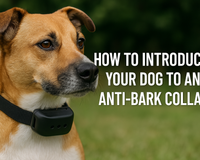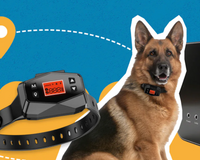Barking is natural for dogs, but excessive barking can become a nuisance. Anti-bark collars can help manage this behaviour. Here's a step-by-step guide to introducing your dog to an anti-bark collar, with expert advice to ensure success.
Why Use an Anti-Bark Collar?
Dogs bark for various reasons: attention, anxiety, or alerts. Managing excessive barking improves the quality of life for both you and your dog. For more tips on curbing barking, check out our detailed guide on How to Stop a Dog Barking in Seconds.
How to Choose the Right Anti-Bark Collar:
Selecting the right collar is crucial for effective training. Here are three excellent options:- Houndware 2-in-1 Pro Anti-Bark and Remote Training Collar Upgrade: Combines anti-bark and remote training capabilities, ideal for comprehensive training.
- Houndware Multi-Functional Anti-Bark Collar: Offers various settings to customise the training process according to your dog's needs.
- Barktec Citronella Spray Collar: Uses a harmless citronella spray to deter barking, suitable for dogs sensitive to sound or static corrections.
For more options, you can shop the full range of anti-bark collars.
What are the Differences Between Citronella Collars and E-Collars?
Understanding the differences between citronella collars and e-collars is crucial for selecting the right one for your dog.
Citronella Anti-Bark Collars
- Mechanism: Releases a citronella spray when your dog barks.
- Suitability: Ideal for dogs sensitive to sound or static corrections.
- Advantages: Gentle and humane; the citronella scent is unpleasant but harmless.
- Considerations: Some dogs might get used to the scent over time, reducing its effectiveness.
E-Collars (Electronic Collars)
- Mechanism: You can opt for a sound, vibration or mild static correction.
- Suitability: Effective for most dogs, especially those not responding to other methods.
- Advantages: Adjustable settings allow for customised training levels.
- Considerations: Ensure the correction level is appropriate to avoid causing stress or fear.
Both types of collars have their benefits and considerations. Choosing the right one depends on your dog's temperament and sensitivity.

Our Step-by-Step Guide on Introducing an Anti-Bark Collar:
1. Familiarise Your Dog with the Collar
Expert Tip: Dogs are naturally curious. Allow your dog to sniff and investigate the collar while it is turned off. This helps to reduce any initial fear or anxiety.Introduce the collar without turning it on. Let your dog sniff and examine it. Place it near their food or regular collar to create a positive association.
2. Fit the Collar Properly
Expert Tip: Proper fit is crucial. A collar that is too tight can cause discomfort, while a loose collar may not work effectively.Ensure the collar fits snugly but not too tight. You should be able to insert two fingers between the collar and your dog's neck.
3. Start with the Lowest Setting
Expert Tip: Always start with the least invasive correction. This ensures your dog isn't startled or frightened.For collars with multiple settings, begin at the lowest intensity. This prevents startling or scaring your dog.
4. Observe Your Dog’s Reaction
Expert Tip: Monitoring your dog's reaction is vital. Look for signs of stress such as whining, shaking, or trying to remove the collar.Pay close attention to your dog's behaviour. If they seem comfortable, continue. If they show signs of distress, give them more time to adjust.
5. Gradually Increase the Intensity
Expert Tip: Patience is key. Gradually increase the intensity only if necessary, and always with caution.If your dog continues to bark, gradually increase the intensity. Always monitor their reactions to ensure they are comfortable.
6. Use Positive Reinforcement
Expert Tip: Positive reinforcement can significantly speed up the training process. Rewarding your dog helps them associate the collar with good behaviour.Reward your dog when they respond well to the collar. Treats, praise, and affection reinforce good behaviour.
7. Keep Training Sessions Short
Expert Tip: Short, frequent training sessions are more effective than longer ones. Aim for multiple sessions throughout the day.Short, consistent training sessions are more effective. Aim for 10-15 minutes per session to avoid overwhelming your dog.
8. Monitor Progress
Expert Tip: Keep a training diary. Note your dog's responses and any changes in behaviour.Track your dog's progress. If you see improvement, stick with the same method. If not, adjust your approach as needed.

Tips for Success
- Consistency: Use the collar regularly to reinforce training.
- Patience: Every dog is different; some may take longer to adjust.
- Consult a Professional: If needed, seek advice from a professional trainer.
Final Thoughts
Introducing an anti-bark collar can help manage excessive barking. With patience and consistency, your dog will learn to understand the collar and reduce unnecessary barking. For more information on anti-bark collars and other training tools, check out:- Houndware 2-in-1 Pro Anti-Bark and Remote Training Collar Upgrade
- Houndware Multi-Functional Anti-Bark Collar
- Barktec Citronella Spray Collar











